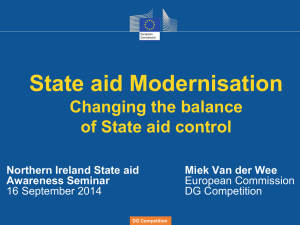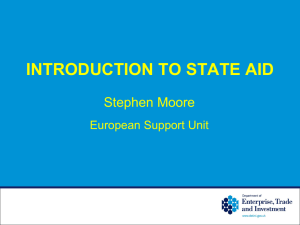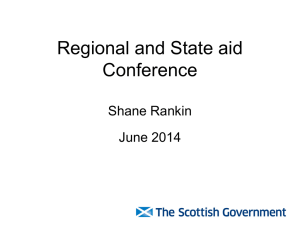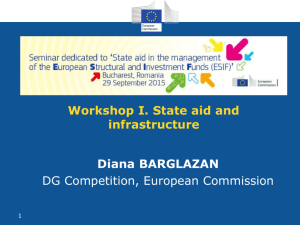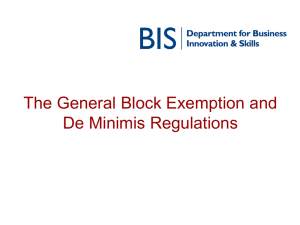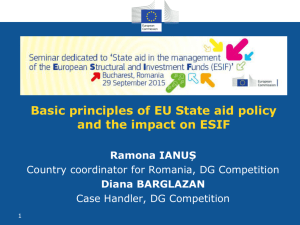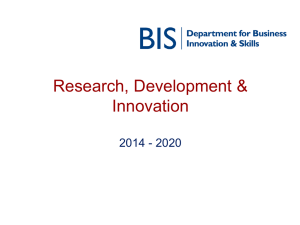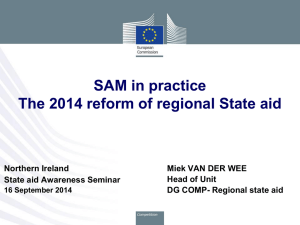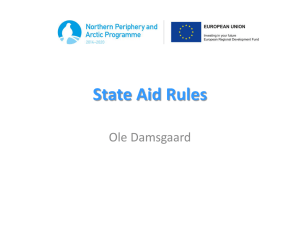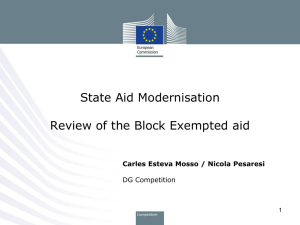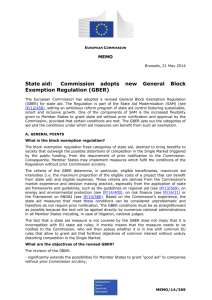Miek van der Wee Presentation
advertisement
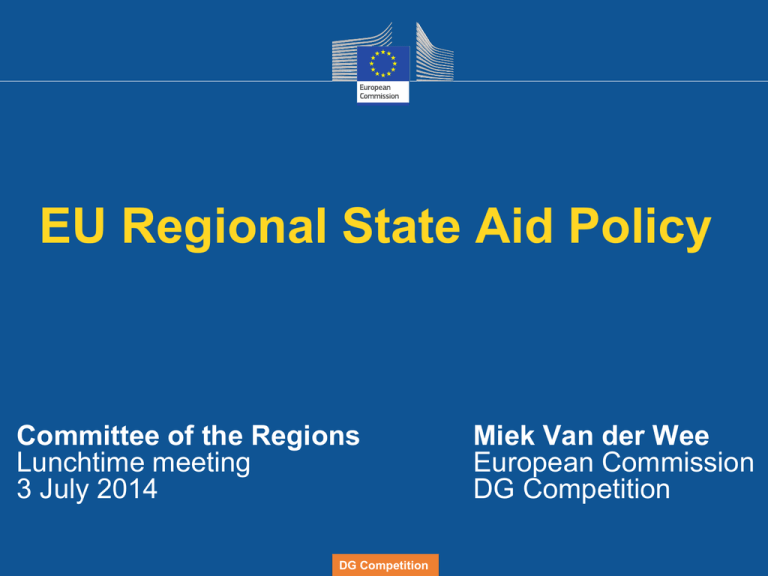
EU Regional State Aid Policy Committee of the Regions Lunchtime meeting 3 July 2014 DG Competition Miek Van der Wee European Commission DG Competition Overview 1. Rationale for State aid control 2. Basic principles of EU State Aid policy 3. Regional aid 4. State aid Modernisation (SAM) 5. Conclusion 6. Q&A DG Competition 1. Rationale for State aid control 2. Basic principles of EU State Aid policy 3. Regional State aid 4. State aid Modernisation (SAM) 5. Conclusion 6. Q&A DG Competition Why do we control State aid ? ■ MS are tempted to subsidise national firms to strengthen their competitive position or to delay restructuring ■ Negative effects: ► Distorted price signals inefficient allocation of resources ► Weakening of dynamic incentives to innovate and adapt ► Subsidy races Impact on public finance and cohesion DG Competition Question 1 The less developed Member States grant higher levels of State aid than the more developed Member States True False DG Competition State aid and cohesion - 1 2007-2012 10 Richest MS 7 Poorest MS 129 33 State aid (as % of GDP) 0.64% 0.86% State aid (annual, per capita) € 212 € 72 € 44 bn € 6 bn GDP per capita (EU27 = 100) State aid Volume (billion € / year) DG Competition State aid and cohesion - 2 DG Competition Why do we control State aid ? ■ State aid is not always “bad” though: ► ► Markets do not always deliver optimal outcomes due to market failures: ● Externalities, ● Imperfect information ● Equity issues SA can be effective instrument to overcome market failures ■ Therefore: Need for a nuanced approach to State aid DG Competition 1. Rationale for State aid control 2. Basic principles of EU State Aid policy 3. Regional State aid 4. State aid Modernisation (SAM) 5. Conclusion 6. Q&A DG Competition Basic principles of SA policy - 1 ■ EU SA policy established in 1958 Treaty of Rome ■ Main objective: ► Avoid distortion of competition in internal market ► Support economic and social cohesion DG Competition Basic principles of SA policy - 2 ■ Substance (Article 107 TFEU): ► SA in principle “incompatible” with the common market ► Exemptions from ban defined in the Treaty ■ Procedure (Article 108 TFEU): ► COM has exclusive competence to control exemptions ► Ex ante control: Notification + Standstill obligation ► Violation of SA rules: ● Complaints + Ex Officio investigations ● EC orders recovery of illegal & incompatible SA DG Competition Basic principles of SA policy - 3 Two key questions in State aid: Q 1: When does a measure constitute “State aid” ? Definition of “State aid” Q 2: When is a State aid measure “compatible” with the Internal Market? Compatibility of State Aid? DG Competition Question 1: When does a measure constitute “State aid”? DG Competition Definition of “State aid” Definition of “State aid” is contained in Art. 107(1) TFEU: Save as otherwise provided in the Treaties, any aid granted by a Member State or through State resources in any form whatsoever which distorts or threatens to distort competition by favouring certain undertakings or the production of certain goods shall, insofar as it affects trade between Member States, be incompatible with the common market” DG Competition Definition of State aid ■ Four criteria defining a measure as “State aid” : ► Aid granted by a Member State or through State resources; ► Providing an advantage (“favouring”) to an undertaking ► It is selective (“certain” undertakings or “certain” goods) ► It effects trade between Member States ■ All four criteria need to be fulfilled simultaneously! DG Competition Definition of State aid: Examples ■ Examples of state aid measures: ► Grants to individual companies ► Reduction of corporate tax rate & social security contributions ► Interest rate subsidy ► Land sold below market price ■ Examples of non-aid measures: ► Measures applying to all companies in all sectors (no discretionary power) ► Regulatory measures with no state resources DG Competition Question 2: When is a State aid measure compatible with the internal market ? DG Competition Compatibility: “Exemptions” ■ TFEU defines exemptions from ban on SA such as: ► Aid to promote the development of less developed regions or of certain economic activities ► Aid to promote culture and heritage conservation ■ Exemptions are not unconditional: ► Aid should contribute to an objective of common interest ► Aid should “not adversely affect trading conditions to an extent contrary to the common interest” ► COM controls application of exemptions DG Competition Compatibility: “Balancing test” ■ Assessment of compatibility “balancing test”: ► Benefits (contribution to objective of EU interest) ► Costs (distortion of competition and trade) ■ Compatibility assessment covers i.a. ► Contribution to objective of common interest? ► Incentive effect? ► Is the aid proportional? ► Distortions of competition limited? DG Competition Compatibility: “Codification of criteria” ■ COM codified “compatibility criteria” for main categories of SA ► Criteria: Eligible projects and costs, max. aid intensities … ► Guidelines, Regulations, Notices for : ● Horizontal aid: Regional aid, SME, Training, RTD, Environment, … ● Sectoral aid: Broadband, Airlines, Audiovisual, … ■ Published on DG Competition’s website: http://ec.europa.eu/competition/state_aid/legislation/compilation/index_en.h tml DG Competition Compatibility: “Procedural aspects” ■ General Rule: All aid to be notified & approved ■ Exceptions: ► Aid under approved aid schemes ► Aid under General Block Exemption Regulation (GBER) ● COM defined clear compatibility criteria for certain types of aid (SME aid, Regional Investment aid, …) ● Aid measures satisfying these conditions are exempted from notification & standstill requirement ■ Aid not falling under these exceptions and granted without Commission approval is “illegal aid” DG Competition State aid Architecture NO De Minimis AID Too small to distort trade No Notification No Information Cumulation control Block AID Exemption Regulation • Routine aid • Clear compatibility criteria • Limited risk of distortion No Notification Information sheet Guidelines, • Criteria published AID frameworks, • Potential compatibility issues (distortion, incentive effect, …) etc. Directly on AID TFEU • Very limited experience • No criteria published • Ad hoc assessment DG Competition Ex Ante Notification Ex Ante Notification 1. Rationale for State aid control 2. Basic principles of EU State Aid policy 3. Regional State aid 4. State aid Modernisation (SAM) 5. Conclusion 6. Q&A DG Competition Regional State aid aid - Importance Total State aid 2007-2013 (€360 bn) EU cohesion policy 2007-2013 (€347 bn) Regional aid (€98 bn)* DG Competition * estimates Regional aid ■ Purpose of regional aid: To promote the development of disadvantaged areas by addressing their economic handicaps ■ How? ► Support for investment and job creation by undertakings ► Support for operating expenses of undertakings ■ Criteria set out in RAG + GBER: ► Where can regional aid be granted? ► What can aid be granted for? ► How much aid can be granted? DG Competition Regional aid maps To be effective: regional aid should target problem areas ■ Areas with abnormally low standard of living Art.107(3)(a) ► Reference point is EU average ► Criterion GDP/cap lower than 75% EU average Outer Most Regions (Art. 349 TFEU) ■ Other disadvantaged areas Art. 107(3)(c) ► Ex-Article 107(3)(a) regions (2011-2013) ► Sparsely populated area s ► Other problem regions with population of at least 50,000 DG Competition Regional aid maps Comparison population coverage 2006-2013 and 2014-2020: Types of region 'a' areas - GDP/cap < 75% - Outermost regions ‘c’ areas 2014-2020 2006-2013 25.8% 33.0% 24.9% 32.1% 0.9% 0.9% 21.8% 13.6% - Former ‘a’ regions 6.9% - Sparsely populated 0.6% - Other ‘c’ areas 14.3% Total ‘a’ + ‘c’ 47.6% DG Competition 46.6% Regional aid maps Regional aid map also places limits on the amount of investment aid that can be granted in each region: Assisted area (% EU GDP/head) Large firms 2006-13 2014-20 Medium firms Small firms 'a' areas (<45%) 50% 50% +10% +20% 'a' areas (45%-60%) 40% 35% “ “ 'a' areas (60%-75%) 30% 25% “ “ 15% “ “ 15% 15% “ “ 10%-15% 10% “ “ Ex 'a' areas (until end ‘17) Sparsely populated areas, external border areas Other 'c' areas DG Competition Regional aid maps 2013 DG Competition Regional aid maps 2014-2020 Population coverage (%) Bulgaria, Estonia, Latvia, Lithuania Greece Malta Poland Romania Slovenia Slovakia Czech Republic Portugal Hungary Spain Ireland Cyprus Italy Belgium UK Finland Germany Austria France Sweden Denmark Luxembourg Netherlands Total 2014 ‘a’ areas 100.0 100.0 100.0 100.0 100.0 100.0 88.5 88.1 85.0 76.7 68.6 51.3 50.0 34.1 29.9 27.0 26.0 25.8 25.8 24.1 12.3 8.0 8.0 7.5 100.0 45.9 DG Competition 86.3 89.4 52.9 88.5 88.1 69.2 70.4 6.8 29.0 3.9 2.9 ‘c’ areas 54.1 100.0 13.7 10.6 47.1 15.8 6.3 61.8 51.3 50.0 5.0 30.0 23.2 26.0 25.8 25.8 21.2 12.3 8.0 8.0 7.5 Investment aid: “Eligible projects” ■ Investment in tangible and intangible assets relating to In 'a' regions & SME in 'c' areas: LEs in 'c' areas: - Setting up of a new establishment; - Diversification of output of establish- - Setting up of a new establishment; - Diversification of activity of establish- - ment into products not previously produced in the establishment; Extension of the capacity of an existing establishment; Fundamental change in the production process. ment, if new activity is not same as or similar to activity previously performed in the establishment; - Diversification of existing establishments into new products or new process innovations. ■ Acquisition of assets linked to establishment that has closed ■ No replacement investment! DG Competition Investment aid: “Eligible costs” Two ways to calculate “eligible costs”: ■ Costs calculated on the basis of investment costs: ► Material assets (land, building, equipment) ► Immaterial assets (Transfer of technology, Patents, Knowhow licenses, …) ■ Costs calculated on the basis of wage costs: Wage costs arising from job creation as a result of the initial investment (two-year wage cost) DG Competition Investment aid: “How much aid?” ■ Maximum allowable aid is defined as a percentage of eligible costs of the initial investment ■ Maximum aid intensity is set in the regional aid maps and depends on: ► The level of development of the region ► The size of the enterprise ► The size of the investment project ● Regional aid ceilings set in regional aid maps apply to investments with a total eligible cost of less than 50 Mio€ ● For larger investment projects (LIPs): scaling down of maximum aid intensity ceiling DG Competition Investment aid: “Other conditions” ■ Maintenance of investment (or jobs) in the region: ►5 years for large enterprises ►3 years for SMEs ■ 25% of investment should be from own contribution or external finance, but totally free of public support ■ Formal application for aid before works on the project started (formal incentive effect) DG Competition Operating aid ■ Aid not linked to investment project, but aimed at reducing a firm’s current expenses ■ Permitted exceptionally in cases where investment aid alone is not enough to trigger regional development: ► The least developed ‘a’ regions (SME only) ► The sparsely populated ‘c’ regions (SME + LE) ► Outer Most Regions (SME + LE) ■ MS to demonstrate that the aid is “proportionate”: ► No over-compensation of extra costs facing companies as a result of specific regional handicaps DG Competition 1. Rationale for State aid control 2. Basic principles of EU State Aid policy 3. Regional State aid rules 4. State aid modernisation (SAM) 5. Conclusion 6. Q&A DG Competition SAM - Objectives ■ Communication on “State Aid Modernisation” (2012) ► Support growth in times of budget constraints ► "More with less“ ■ Stricter control of more distortive aid: ► Prove real incentive effect ► Limit aid to what is necessary (proportionality) ■ Simplify rules for "good aid" Review of GBER DG Competition State aid under GBER schemes ■ Situation 2011 63% of aid measures in EU were implemented under GBER 14% GBER Notified Schemes 23% Notified Individual Aid 63% ■ Ambition 2014-20 90% of aid under GBER DG Competition SAM – Impact on Regional aid Facilitate granting of less distortive aid that contributes to cohesion: ■ Widening the scope of the GBER: ► Investment aid schemes ► Individual investment aid (< € 7.5 mio in normal ‘c’ region) ► Operating aid (<10% of turnover or <25% of labour cost) ■ No need to notify, but: ► Transparency ► Evaluation of large schemes DG Competition Regional aid under GBER schemes DG Competition SAM - Impact on Regional aid ■ Notification requirement for more distortive aid: ► Large investment aid projects ► Investment projects of companies closing down activities ► Operating aid schemes exceeding GBER ceilings ■ Stricter assessment ► Incentive effect on the basis of counter-factual analysis ► Proportionality Double ceiling: ► ● Regional aid intensity ceiling ● Minimum aid needed for project to go ahead Black list: Aid linked to delocalisation DG Competition 1. Rationale for State aid control 2. Basic principles of EU State Aid policy 3. Regional State aid rules 4. State aid modernisation (SAM) 5. Conclusion 6. Q&A DG Competition Conclusion ■ Nuanced approach to SA control ► SA can distort markets + undermine cohesion ► SA can also be effective tool to address market failures ■ TFEU: SA Prohibition + Exemptions controlled by COM ■ SAM: ► Facilitate granting of less distoprtive aid measures contributing to EU2020 objectives ► Stricter control of most distortive aid measures ► This is also reflected in reform of regional aid for 2014-2020 DG Competition Thank you ! DG Competition
